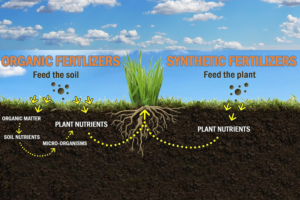
Introduction
Why Fertilize Your Lawn?
Every gardener and landscaper knows the joy of seeing a lush, green lawn. Fertilizing is like giving your lawn a health boost, ensuring it gets the essential nutrients it needs to thrive. Just as we need a balanced diet to stay healthy, our lawns require the right mix of nutrients to grow thick, resist diseases, and fend off pests. By understanding the types of fertilizers available, you can make an informed decision that will make your lawn the envy of the neighborhood.
The choice between organic and chemical fertilizers is at the heart of the lawn care debate. Organic fertilizers are derived from natural sources like plants, animals, or minerals. They release nutrients slowly, providing long-term nourishment for the grass. On the other hand, chemical fertilizers are manufactured and can give your lawn a quick nutrient boost. Both have their merits, and the choice often comes down to personal preference, environmental considerations, and specific lawn needs. We’ll delve deeper into these options, helping you decide which is best for your green oasis.
The Role of N-P-K in Fertilizers
You might have noticed three numbers on fertilizer bags, like 10-20-10. These numbers represent the percentage of Nitrogen (N), Phosphorus (P), and Potassium (K) in the fertilizer. Each of these nutrients plays a crucial role in lawn health. Nitrogen promotes lush, green growth; Phosphorus supports strong root development; and Potassium ensures overall plant health and disease resistance. By understanding the needs of your lawn, you can select a fertilizer with the proper N-P-K ratio to ensure optimal growth and health.
Choosing the Right Fertilizer for Your Lawn
Every lawn is unique, with its own set of challenges and needs. Factors like soil type, climate, and grass variety all play a role in determining the best fertilizer for your lawn. With so many options available, it can be overwhelming to choose the right one. But don’t worry! In this guide, we’ll break down the different types of fertilizers, their benefits, and how to use them effectively. Whether you’re a seasoned gardener or starting, you’ll find valuable insights to help your lawn flourish.
By the end of this guide, you’ll be equipped with the knowledge to make informed decisions about lawn fertilization. So, let’s dive in and explore the world of lawn fertilizers, ensuring your lawn remains a vibrant and thriving space for all to enjoy!
Organic vs. Chemical Fertilizers
The Basics of Organic Fertilizers
Organic fertilizers are akin to home-cooked meals for your lawn. Derived from natural sources such as plants, animals, and minerals, they ensure a slow and steady release of nutrients. This means your lawn receives a consistent nutrient supply over time. They feed the grass, and organic fertilizers enrich the soil, enhancing its structure and ability to hold water and nutrients. This environment promotes deep and strong grass root growth.
Furthermore, organic fertilizers are environmentally friendly. Made from renewable resources, they lack synthetic chemicals, reducing the risk of water pollution. They’re also safe for beneficial insects, pets, and children playing on the lawn. You’ll likely observe improved soil health as you continue using organic options, leading to a more resilient and vibrant lawn.
Understanding Chemical Fertilizers
Chemical or synthetic fertilizers act as a quick nutrient boost for your lawn. If your grass appears pale or thin, a chemical fertilizer can rejuvenate its green hue swiftly. These fertilizers are crafted for efficiency, ensuring your lawn receives precise nutrients promptly.
However, it’s crucial to apply chemical fertilizers with care. Overuse can lead to nutrient burn, potentially damaging the grass. Additionally, nutrient runoff from excessive use can pollute water sources. But when used appropriately, chemical fertilizers can be highly effective, delivering rapid results and lush growth. The key lies in understanding your lawn’s requirements and applying the product in moderation.
Are you making a choice: Organic or Chemical?
Deciding between organic and chemical fertilizers isn’t always straightforward, as both offer unique benefits. Organic options provide long-term advantages, enhancing soil health and structure while being eco-friendly. Chemical fertilizers, on the other hand, deliver immediate results and can be customized to offer specific nutrients.
Your choice might depend on personal preferences, the specific needs of your lawn, and environmental considerations. Some gardeners prefer the gradual approach of organic fertilizers, while others value the immediate effects of chemical ones. Regardless of your choice, it’s essential to use the product responsibly, prioritizing the health of your lawn and the surrounding environment. With informed decisions, either choice can lead to a beautiful, envy-worthy lawn!
Granular Fertilizers
Dry Granular Fertilizers
Granular fertilizers are a favorite among many gardeners, and the dry variant is prevalent. Why? Because it’s easy to handle, store, and apply. Dry granular fertilizers are solid granules you can sprinkle or spread across your lawn using a spreader. These tiny power-packed particles slowly release nutrients into the soil, ensuring a steady feed for your grass.
The beauty of dry granular fertilizers lies in their simplicity. You don’t need any special equipment or knowledge to use them. Just read the label for the recommended amount, spread them evenly, and you’re good to go. Over time, watering or rain will help these granules break down, releasing their nutrients. It’s a fuss-free, effective way to ensure your lawn gets nourished.
Wet Granular Fertilizers
Wet granular fertilizers, sometimes known as “wettable powders,” might sound a bit complex, but they’re just as user-friendly as their dry counterparts. These are granules that you mix with water before application. Once mixed, you can spray them onto your lawn, ensuring an even distribution of nutrients. This method allows the nutrients to become immediately available to the grass, making it a great choice when your lawn needs a quick pick-me-up.
One of the advantages of wet granular fertilizers is the control they offer. You can decide the concentration by adjusting the water-to-fertilizer ratio, allowing for a customized nutrient boost tailored to your lawn’s needs. Additionally, since they’re applied in a liquid form, they provide more uniform coverage, ensuring every inch of your lawn gets its share of nutrients. It’s a versatile and effective way to keep your lawn in shape.
The Benefits of Granular Fertilizers
Granular fertilizers, whether dry or wet, offer a range of benefits that make them a top choice for many gardeners and landscapers. Their ease of use is undoubtedly a significant advantage. There is no need for complex calculations or equipment; just spread or spray and let nature do the rest. The slow-release nature of these fertilizers ensures that your lawn gets a steady supply of nutrients, promoting consistent growth and health.
Moreover, granular fertilizers are cost-effective. A single application can feed your lawn for weeks, reducing the need for frequent reapplications. They’re also easy to store, with a longer shelf life than many liquid fertilizers. Whether you’re a seasoned gardener or just starting, granular fertilizers offer a simple, effective, and economical way to ensure your lawn looks its best all year round.
Liquid Fertilizers
Foliar Sprays
Foliar sprays are a type of liquid fertilizer that gardeners apply directly to the leaves of plants. This method might seem unconventional, but it’s based on the idea that plants can absorb nutrients through their leaves quickly and efficiently. For those moments when your lawn seems to be lacking a certain sparkle or when you notice a deficiency, foliar sprays can act as a quick remedy, providing immediate nutrients.
The beauty of foliar sprays is their rapid action. Unlike other fertilizers that need to be absorbed by the roots, foliar sprays give plants a direct nutrient boost. This is especially useful in situations where the soil might be preventing nutrient uptake, such as in soil compaction or imbalanced pH. However, it’s essential to use foliar sprays judiciously. They’re meant to supplement, not replace, regular fertilization. Think of them as a vitamin boost for your lawn, helping it overcome temporary challenges and regain its lush appearance.
Soil Drenches
Soil drenches are another form of liquid fertilizer, but instead of targeting the leaves, they focus on the roots. As the name suggests, soil drenching involves saturating the soil around the plant’s base, ensuring that the nutrients reach the roots directly. This method is particularly effective for deep-rooted plants or when you want to address specific root-related issues.
Using soil drenches ensures that the nutrients are immediately available to the plant’s roots, promoting strong and healthy growth. It’s an efficient and thorough method, ensuring that every part of the root system gets nutrients. For gardeners dealing with nutrient-locked soils or those who want to give their plants a deep nourishing treatment, soil drenches are an excellent choice. They provide targeted nutrition, helping plants grow stronger from the ground up.
The Advantages of Liquid Fertilizers
Liquid fertilizers, whether as foliar sprays or soil drenches, offer several benefits that make them a favorite among many gardeners. Firstly, they provide immediate results. Since they’re in liquid form, plants can absorb them quickly, making them perfect for addressing deficiencies or giving plants a quick nutrient boost.
Additionally, liquid fertilizers offer precision. Gardeners can adjust the concentration to suit their plants’ needs, ensuring they get the proper nutrients. They’re also easy to apply, requiring no special equipment or techniques. Whether you’re looking to address a specific deficiency, give your plants a quick nutrient boost, or simply want an easy fertilizer, liquid fertilizers are a versatile and practical choice. With their help, you can ensure that your lawn and garden remain vibrant, lush, and healthy throughout the year.
Slow-Release vs. Fast-Release Fertilizers
Slow-Release Fertilizers
Slow-release fertilizers are like the marathon runners of the gardening world. They provide a steady and prolonged supply of nutrients to your lawn or garden, ensuring that plants receive what they need over an extended period. This gradual nutrient release means you don’t have to fertilize as often, making it a convenient choice for those with busy schedules or who prefer a more hands-off approach to lawn care.
The primary advantage of slow-release fertilizers is their ability to provide consistent nutrition. There’s no risk of nutrient burn, a common issue when too much fertilizer is applied at once. Instead, plants get a balanced diet, leading to healthier growth, stronger roots, and a more vibrant appearance. Slow-release fertilizers are an excellent choice for gardeners looking for a low-maintenance fertilization method that delivers reliable results.
Fast-Release Fertilizers
Fast-release fertilizers are the sprinters in the race. They deliver nutrients quickly, providing plants with an almost instant boost. If your lawn or garden shows signs of nutrient deficiency or is preparing for a special event and wants it to look its best, fast-release fertilizers can provide the quick fix you need.
While fast-release fertilizers offer immediate results, they come with a few caveats. Applying them carefully is essential, following the recommended dosage to avoid over-fertilization. They also require more frequent applications compared to their slow-release counterparts. However, when used correctly, fast-release fertilizers can be a gardener’s best friend, providing rapid results and helping plants recover from stress or deficiencies.
Making the Right Choice: Slow vs. Fast
Choosing between slow-release and fast-release fertilizers often comes down to your gardening goals and the specific needs of your lawn or plants. If you’re looking for a set-it-and-forget-it solution that provides consistent nutrition over time, slow-release fertilizers are the way to go. They’re especially beneficial for establishing new plants or maintaining lawns and gardens.
On the other hand, if you’re dealing with nutrient deficiencies or preparing for a special occasion, fast-release fertilizers offer the rapid results you need. They also benefit plants with short growing seasons needing immediate nutrient boosts.
Ultimately, both slow-release and fast-release fertilizers are in the gardener’s toolkit. By understanding the unique benefits of each and assessing the needs of your lawn or garden, you can make an informed decision that will ensure your plants thrive. With the right fertilizer choice, your garden will be the talk of the town, showcasing vibrant colors, lush growth, and overall health.
Specialty Fertilizers
Starter Fertilizers
When establishing a new lawn or garden, giving plants the best start is crucial. Enter starter fertilizers, specially formulated to give young plants and new grass the essential nutrients they need during their initial growth phase. These fertilizers are rich in phosphorus, a critical element that promotes strong root development, ensuring that new plants are established quickly and effectively.
Using a starter fertilizer can significantly affect how well a new lawn or garden establishes. Think of it as laying a solid foundation for a house. With the proper nutrients from the outset, plants are more resilient, grow more vigorously, and are better equipped to handle stress, be it from pests, diseases, or environmental factors. For gardeners looking to give their new plants the best possible start, starter fertilizers are an invaluable tool in the gardening arsenal.
Weed and Feed Fertilizers
Balancing the need to fertilize your lawn while combating weeds can be challenging. That’s where “weed and feed” fertilizers come into play. These dual-action products nourish your lawn while simultaneously targeting unwanted weeds. They’re designed to provide the grass with essential nutrients while preventing weeds from absorbing what they need to grow, effectively starving them.
The beauty of weed and feed fertilizers is their efficiency. Instead of applying a separate herbicide and then fertilizing, gardeners can tackle two tasks at once. This saves time and ensures the lawn gets the nutrition it needs without competition from pesky weeds. However, applying these fertilizers carefully and at the right time is essential to maximize their effectiveness. By following the product’s guidelines and understanding the specific weeds you’re targeting, you can achieve a lush, weed-free lawn that’s the envy of the neighborhood.
The Benefits of Specialty Fertilizers
Specialty fertilizers, as the name suggests, are designed for specific purposes. Whether establishing a new garden, combating persistent weeds, or addressing a particular nutrient deficiency, there’s likely a specialty fertilizer tailored to your needs. These products take the guesswork out of lawn and garden care, providing targeted solutions for specific challenges.
The advantage of using specialty fertilizers is the precision they offer. Instead of using a one-size-fits-all approach, gardeners can address specific issues more effectively. This leads to better results and ensures that plants get exactly what they need when needed. Specialized fertilizers offer tailored solutions that deliver outstanding results for gardeners looking to elevate their lawn and garden care. With their help, you can tackle specific challenges head-on, ensuring your lawn and garden remain vibrant, healthy, and thriving throughout the year.
Fertilizer Nutrient Ratios
Understanding N-P-K
Every gardener, novice or expert, has encountered those three numbers on a fertilizer bag, often separated by dashes, like 10-20-10. These numbers aren’t just random figures; they represent the nutrient ratios of Nitrogen (N), Phosphorus (P), and Potassium (K) in the fertilizer. These three elements are vital for plant growth, each serving a unique purpose. Nitrogen is essential for green growth, making it crucial for lawns and leafy plants. Phosphorus supports robust root development and is vital when establishing new plants. Conversely, potassium ensures overall plant health, aiding disease resistance and improving drought tolerance.
Knowing the N-P-K ratio of your fertilizer isn’t just about understanding what’s in the bag. It’s about tailoring your fertilization to your garden’s specific needs. A higher nitrogen content might be the answer if your lawn looks yellow. If you’re planting a new garden, a phosphorus-rich fertilizer will help plants establish faster. By understanding these ratios, gardeners can make informed choices, ensuring their plants get the proper nutrients in the right amounts.
Secondary and Micronutrients
While N-P-K might be the stars of the fertilizer world, they’re not the only nutrients plants need. Enter secondary and micronutrients. Secondary nutrients include Calcium (Ca), Magnesium (Mg), and Sulfur (S). These elements might not be needed in the exact quantities as N-P-K, but they’re still vital for plant health. Calcium is crucial for cell wall formation; Magnesium is a component of chlorophyll, and Sulfur aids in certain amino acids and vitamins.
Beyond these, plants also require micronutrients, which, as the name suggests, are needed in tiny amounts. These include elements like Iron (Fe), Manganese (Mn), Zinc (Zn), Copper (Cu), Boron (B), Molybdenum (Mo), and Chlorine (Cl). While they’re required in small quantities, they play significant roles in various plant processes, from enzyme activation to photosynthesis.
The beauty of understanding secondary and micronutrients is that it allows gardeners to address specific deficiencies. Yellowing leaves might indicate an iron deficiency, while poor flower development could indicate a lack of boron. By recognizing these signs and understanding nutrient roles, gardeners can provide targeted solutions, ensuring every plant thrives.
The Importance of Balanced Nutrition
Just as humans need a balanced diet to stay healthy, plants require a mix of macro and micronutrients to thrive. While it’s easy to focus on the big three – N-P-K – it’s essential to remember that plants need various nutrients, each playing a unique role. By providing a balanced nutrient mix, gardeners can ensure robust growth, vibrant blooms, and a resilient garden that can fend off diseases and pests.
Choosing a fertilizer isn’t just picking one with the proper N-P-K ratio. It’s about understanding your garden’s unique needs and providing a balanced nutrient mix to meet those needs. Whether growing a lush lawn, vibrant flowers, or delicious vegetables, balanced nutrition is the key. With the proper nutrients and amounts, every plant in your garden can shine, making your little patch of green a source of joy and pride.
How to Select the Ideal Fertilizer for Your Lawn
Assessing Your Lawn’s Soil
Every lawn is unique, and its success starts from the ground up. To ensure your grass thrives, it’s crucial to understand the specific needs of your lawn’s soil. A straightforward soil test can be a game-changer, revealing pH levels, nutrient concentrations, and more details.
With these insights, you can identify any nutrient deficiencies or imbalances your lawn might face. Maybe your soil is alkaline, or perhaps it’s low in nitrogen. Knowing these specifics allows you to select a fertilizer that directly addresses your lawn’s needs. The aim is to green up your grass and foster a balanced, nutrient-rich foundation for sustained lawn health. Starting with a soil assessment is the first step toward a lush, vibrant lawn.
Understanding Grass Needs
Just as different plants have varied nutritional requirements, so do different grass types. Whether you have Bermuda, Kentucky Bluegrass, or St. Augustine, each grass type has unique needs. Some grasses might need more nitrogen to maintain their lush appearance, while others require higher potassium levels for drought resistance.
It’s also essential to consider your lawn’s life stage and health. Newly seeded or sodded lawns might benefit from a phosphorus-rich starter fertilizer to encourage root growth. In contrast, mature lawns might just need maintenance fertilization. If your lawn shows yellowing or patchiness, it might signal a specific nutrient deficiency. By catering to your grass type and its specific needs, you ensure it gets the proper nutrients for optimal health and appearance.
Considering Application Methods
The market offers many fertilizer options, each with its application method. The choices can be overwhelming, from granular to liquid, from slow-release formulations to those that offer immediate results. Your decision often hinges on your lawn’s needs and your personal preferences. For instance, granular fertilizers are fantastic for providing nutrients over an extended period, ideal for established lawns. On the other hand, liquid fertilizers can give your lawn a quick nutrient boost, perfect for addressing immediate deficiencies.
Think about your comfort level with the application process. While some homeowners love the precision of liquid fertilizers and hose-end sprayers, others might prefer the ease of a broadcast spreader with granular products. Your fertilization frequency preference also plays a role. Slow-release options mean fewer applications while fast-acting ones require more regular schedules. Balancing your lawn’s needs with your application preferences ensures you select a fertilizer that’s both effective and user-friendly.
Embracing Trial and Error
Lawn care, like gardening, often involves a learning curve. While expert advice, soil tests, and product labels are invaluable, there’s room for trial and error. If a particular fertilizer doesn’t green up your lawn as expected, it might be worth trying a different blend or brand. Observe how your lawn responds, adjust your approach based on the results, and learn as you go.
Every lawn’s unique combination of soil, grass type, and environmental conditions will have its specific needs. You can fine-tune your lawn care routine by being open to experimentation and staying observant. Over time, this hands-on approach will deepen your understanding of your lawn’s needs, guiding you towards choices that ensure it remains lush, green, and the envy of the neighborhood.
FAQ
What’s the importance of a soil test for my lawn?
A soil test provides insights about pH levels, nutrient concentrations, and more, allowing you to identify any nutrient deficiencies or imbalances. This helps in selecting a fertilizer that directly addresses your lawn’s specific needs.
How do different grass types affect fertilizer choice?
Different grass types, like Bermuda or Kentucky Bluegrass, have unique nutritional requirements. Understanding these needs ensures your grass gets the right nutrients for optimal health and appearance.
What are the differences between granular and liquid fertilizers?
Granular fertilizers provide nutrients over an extended period and are ideal for established lawns. Liquid fertilizers offer a quick nutrient boost, perfect for addressing immediate deficiencies and can be applied with precision.
How often should I fertilize my lawn?
The frequency depends on the type of fertilizer and your lawn’s needs. Slow-release options might require fewer applications, while fast-acting ones could need a more regular schedule. Always refer to product guidelines for specific advice.
Why might my lawn be yellowing or patchy?
Yellowing or patchiness can signal a specific nutrient deficiency. It’s essential to cater to your grass type and its specific needs, possibly adjusting your fertilization approach based on observed lawn health.
Is it okay to experiment with different fertilizers?
Yes, lawn care often involves a learning curve. While expert advice and product labels are invaluable, there’s also room for trial and error. Observing how your lawn responds and adjusting your approach based on results can be beneficial.
Conclusion
The Journey of Lawn Care
Caring for a lawn is much like nurturing a living tapestry. Every blade of grass, every patch of soil, and every drop of water contributes to a vibrant canvas that evolves with each season. As gardeners and landscapers, the journey of lawn care is both a responsibility and a joy. It’s about understanding the unique needs of the grass, the soil, and the environment, and then making informed decisions to ensure the lawn thrives.
The beauty of this journey is that it’s ever-evolving. With each passing season, as you observe, learn, and adapt, your connection with your lawn deepens. The joy of seeing a once patchy area transform into a lush green expanse or the satisfaction of addressing a specific challenge and witnessing the positive results is unparalleled. It’s a testament to the dedication, love, and care you pour into your lawn, making all the efforts worthwhile.
Embracing the Learning Curve
Lawn care, like many other aspects of gardening, is a continuous learning process. Whether you’re a seasoned gardener or someone just starting, there’s always something new to discover, a new challenge to tackle, or a new success to celebrate. It’s this ever-present learning curve that makes lawn care so fulfilling.
Embracing this learning curve means being open to experimentation, staying observant, and being willing to adapt. It’s about understanding that mistakes are merely stepping stones to mastery. With every challenge faced, you gain a deeper understanding of your lawn’s unique needs, allowing you to make better decisions in the future.
So, as you continue on this journey, remember to celebrate every success, learn from every challenge, and always look forward to the endless possibilities that await. Your lawn, with its vibrant hues of green, is a testament to your dedication and passion. And with each passing day, it stands as a symbol of the beautiful bond between nature and nurture.
Additional Resources
- The Basics of Lawn Care: A Comprehensive Guide
- Dive deeper into the fundamentals of lawn care with this comprehensive guide, covering everything from mowing techniques to seasonal maintenance.
- Understanding Soil Types and How They Affect Your Lawn
- A must-read for anyone looking to truly understand their lawn’s foundation. This resource breaks down different soil types and offers advice on how to optimize them for a healthier lawn.
- Choosing the Right Fertilizer for Your Lawn
- This article provides insights into the world of fertilizers, helping you make informed decisions based on your lawn’s specific needs.
- Lawn Watering Tips: When and How to Water Your Grass
- Proper watering is crucial for a thriving lawn. This resource offers expert advice on when and how to water your grass for optimal health.
- Common Lawn Problems and Solutions
- Every lawn faces challenges. This article outlines common lawn problems and offers practical solutions to keep your grass looking its best.
Feel free to explore these resources to further enhance your knowledge and skills in lawn care. Each link provides valuable insights and tips that can benefit both novice and seasoned gardeners.

Bob Green, a passionate lawn care enthusiast with over two decades of landscaping experience, is this website’s proud owner. His vast knowledge of horticulture and dedication to helping homeowners maintain beautiful lawns are reflected in the valuable content he shares on his platform. John has always been interested in Agrostology.













